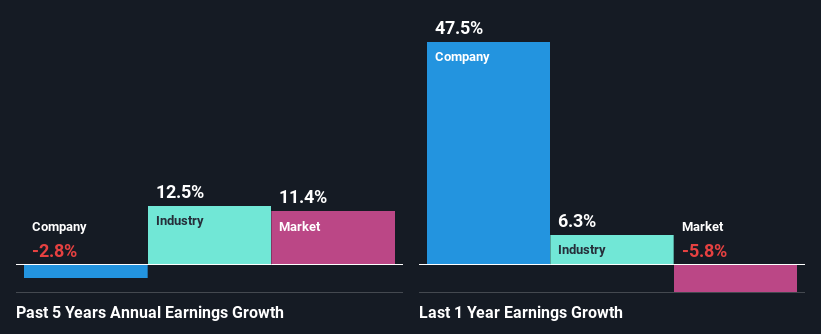Could The Market Be Wrong About The Stock?

It is hard to get excited after looking at Singapore Telecommunications’ (SGX:Z74) recent performance, when its stock has declined 2.5% over the past month. However, stock prices are usually driven by a company’s financials over the long term, which in this case look pretty respectable. Particularly, we will be paying attention to Singapore Telecommunications’ ROE today.
Return on equity or ROE is a key measure used to assess how efficiently a company’s management is utilizing the company’s capital. Simply put, it is used to assess the profitability of a company in relation to its equity capital.
View our latest analysis for Singapore Telecommunications
How Do You Calculate Return On Equity?
ROE can be calculated by using the formula:
Return on Equity = Net Profit (from continuing operations) ÷ Shareholders’ Equity
So, based on the above formula, the ROE for Singapore Telecommunications is:
12% = S$3.2b ÷ S$27b (Based on the trailing twelve months to September 2023).
The ‘return’ is the profit over the last twelve months. That means that for every SGD1 worth of shareholders’ equity, the company generated SGD0.12 in profit.
What Is The Relationship Between ROE And Earnings Growth?
So far, we’ve learned that ROE is a measure of a company’s profitability. Based on how much of its profits the company chooses to reinvest or “retain”, we are then able to evaluate a company’s future ability to generate profits. Assuming everything else remains unchanged, the higher the ROE and profit retention, the higher the growth rate of a company compared to companies that don’t necessarily bear these characteristics.
A Side By Side comparison of Singapore Telecommunications’ Earnings Growth And 12% ROE
To begin with, Singapore Telecommunications seems to have a respectable ROE. Further, the company’s ROE is similar to the industry average of 13%. As you might expect, the 2.8% net income decline reported by Singapore Telecommunications is a bit of a surprise. So, there might be some other aspects that could explain this. Such as, the company pays out a huge portion of its earnings as dividends, or is faced with competitive pressures.
So, as a next step, we compared Singapore Telecommunications’ performance against the industry and were disappointed to discover that while the company has been shrinking its earnings, the industry has been growing its earnings at a rate of 13% over the last few years.
The basis for attaching value to a company is, to a great extent, tied to its earnings growth. The investor should try to establish if the expected growth or decline in earnings, whichever the case may be, is priced in. Doing so will help them establish if the stock’s future looks promising or ominous. What is Z74 worth today? The intrinsic value infographic in our free research report helps visualize whether Z74 is currently mispriced by the market.
Is Singapore Telecommunications Using Its Retained Earnings Effectively?
Singapore Telecommunications’ declining earnings is not surprising given how the company is spending most of its profits in paying dividends, judging by its three-year median payout ratio of 79% (or a retention ratio of 21%). With only a little being reinvested into the business, earnings growth would obviously be low or non-existent. To know the 3 risks we have identified for Singapore Telecommunications visit our risks dashboard for free.
In addition, Singapore Telecommunications has been paying dividends over a period of at least ten years suggesting that keeping up dividend payments is way more important to the management even if it comes at the cost of business growth. Our latest analyst data shows that the future payout ratio of the company over the next three years is expected to be approximately 79%. Accordingly, forecasts suggest that Singapore Telecommunications’ future ROE will be 10% which is again, similar to the current ROE.
Conclusion
In total, it does look like Singapore Telecommunications has some positive aspects to its business. Yet, the low earnings growth is a bit concerning, especially given that the company has a high rate of return. Investors could have benefitted from the high ROE, had the company been reinvesting more of its earnings. As discussed earlier, the company is retaining a small portion of its profits. In addition, on studying the latest analyst forecasts, we found that the company’s earnings are expected to continue to shrink. To know more about the latest analysts predictions for the company, check out this visualization of analyst forecasts for the company.
Have feedback on this article? Concerned about the content? Get in touch with us directly. Alternatively, email editorial-team (at) simplywallst.com.
This article by Simply Wall St is general in nature. We provide commentary based on historical data and analyst forecasts only using an unbiased methodology and our articles are not intended to be financial advice. It does not constitute a recommendation to buy or sell any stock, and does not take account of your objectives, or your financial situation. We aim to bring you long-term focused analysis driven by fundamental data. Note that our analysis may not factor in the latest price-sensitive company announcements or qualitative material. Simply Wall St has no position in any stocks mentioned.




